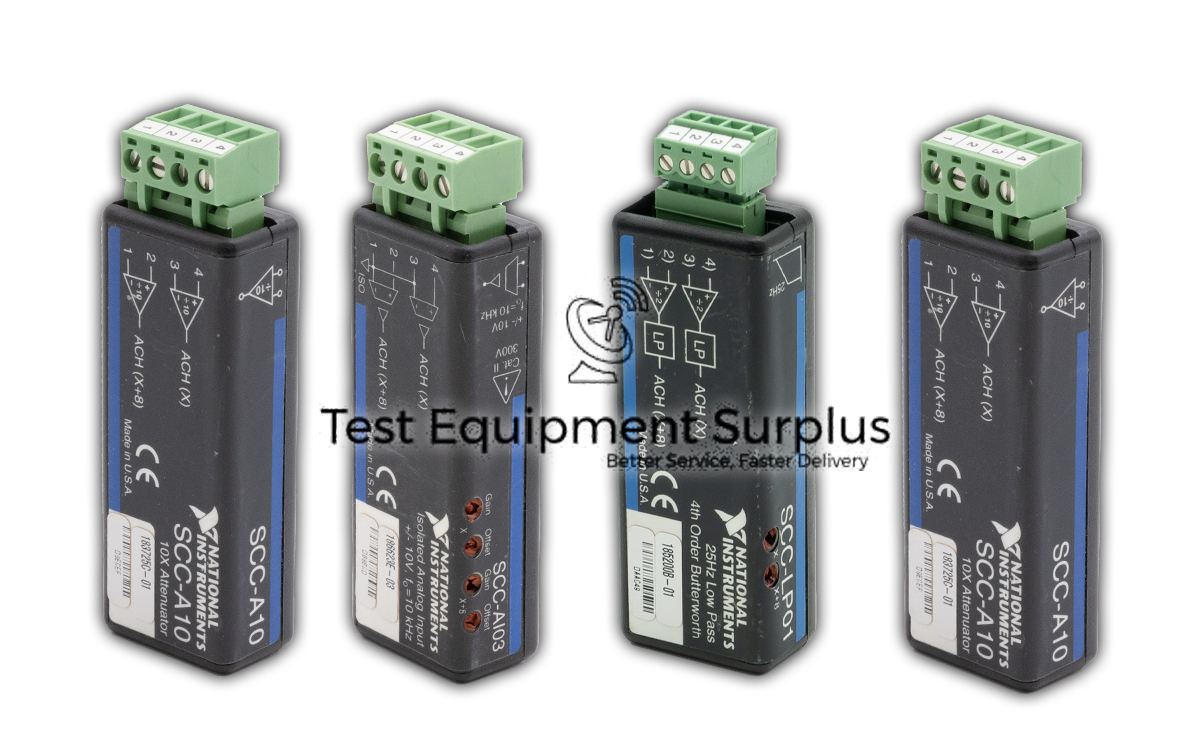Description
The National Instruments SCC-AI14 Isolated Analog Input Module, with Part Number 777459-28, is designed to be compatible with the SC-2345 system.
It features a unique channel configuration where Channel X+8 (utilizing Pins 1 and 2) and Channel X (utilizing Pins 3 and 4) offer channel-to-ground isolation, but not channel-to-channel isolation, ensuring safety and performance in electrical measurements.
With pins 1 and 3 internally connected, the module references a single voltage, and operates in a floating single-ended configuration which allows for a common mode voltage of up to 300 V in a Category II installation scenario.
The SCC-AI14 boasts an input range of +/- 5 V and an output range of +/- 10 V, complemented by a gain factor of 2, and it operates within a bandwidth of 4 Hz. Additionally, with an input voltage rated at 4 V, it can accommodate 2 NRSE input channels.
Furthermore, the module’s bank isolation feature enhances its safety and usability, although the table does not specify the input impedance value.
| Specification | Detail |
|---|---|
| Part Number | 777459-28 |
| Module Type | National Instruments SCC-AI14 Isolated Analog Input Module |
| Compatible With | SC-2345 |
| Channel Configuration | Channel X+8 (Pins 1 and 2), Channel X (Pins 3 and 4) |
| Isolation | Channel-to-ground isolation only (No channel-to-channel isolation) |
| Reference Voltage | Pins 1 and 3 internally connected |
| Configuration | Floating single-ended |
| Common Mode Voltage | Up to 300 V (Category II installation) |
| Input Range | +/- 5 V |
| Output Range | +/- 10 V |
| Gain | 2 |
| Bandwidth | 4 Hz |
| Input Voltage | 4 V |
| Number of Input Channels | 2 NRSE input channels |
| Isolation Type | Bank isolation |
Question 1: What type of isolation is provided between Channel X+8 and Channel X on the National Instruments SCC-AI14 Isolated Analog Input Module?
Answer 1: The National Instruments SCC-AI14 Isolated Analog Input Module provides channel-to-ground isolation between Channel X+8 and Channel X, but does not offer channel-to-channel isolation.
Question 2: What type of isolation is provided between channels on the National Instruments SCC-AI14 Isolated Analog Input Module, and what are the voltage ratings and configuration specifics mentioned for its operation?
Answer 2: The implications of the SCC-AI14’s unique channel configuration, which provides channel-to-ground isolation but not channel-to-channel isolation, means that while the module can safely isolate individual channels from ground potential, interference or crosstalk between adjacent channels is possible, which may affect measurement accuracy in applications where multiple adjacent channels are used simultaneously.
Question 3: What is the common mode voltage capacity for the SCC-AI14 Isolated Analog Input Module when installed in a Category II installation, and how does its channel configuration enhance electrical measurement safety?
Answer 3: The National Instruments SCC-AI14 Isolated Analog Input Module provides channel-to-ground isolation but not channel-to-channel isolation, offers a floating single-ended configuration with a common mode voltage of up to 300 V in a Category II installation, features an input range of +/- 5 V, an output range of +/- 10 V, a gain factor of 2, operates within a bandwidth of 4 Hz, and can handle 2 NRSE input channels with an input voltage rated at 4 V
Question 4: What is the input impedance value for the National Instruments SCC-AI14 Isolated Analog Input Module, part number 777459-28, which is compatible with the SC-2345 system and has a unique channel configuration?
Answer 4: The input impedance value for the National Instruments SCC-AI14 Isolated Analog Input Module, part number 777459-28, is not specified in the provided description.
Question 5: What are the implications of the SCC-AI14’s unique channel configuration for channel-to-ground and channel-to-channel isolation within electrical measurement applications?
Answer 5: The SCC-AI14 Isolated Analog Input Module can handle a common mode voltage of up to 300 V when installed in a Category II installation, and its channel configuration enhances electrical measurement safety by offering channel-to-ground isolation, though not channel-to-channel isolation, which ensures protection against ground loops and common mode noise.



